Burberry's Marketing Management: Strategies, Innovation, and Analysis
VerifiedAdded on 2023/01/07
|14
|4258
|29
Report
AI Summary
This report provides a comprehensive analysis of Burberry's marketing management, focusing on various aspects of its strategies. It begins with an introduction to marketing management and its application to Burberry, a luxury fashion house. The report delves into the role of data in improving relationship marketing, emphasizing how data is used to enhance customer engagement and personalize experiences. It then examines Burberry's segmentation, targeting, and positioning strategies for its apparel segment, considering geographic, demographic, psychographic, and behavioral factors. The report further explores Burberry's innovative approaches in product and service development, highlighting its use of technology and customer-centric strategies. It also evaluates the marketing mix of Burberry and concludes with recommendations and viable solutions for the female demographic, aiming to improve customer needs and overall marketing effectiveness. The report references various sources to support its analysis and findings.

MARKETING
MANAGEMENT
MANAGEMENT
Paraphrase This Document
Need a fresh take? Get an instant paraphrase of this document with our AI Paraphraser
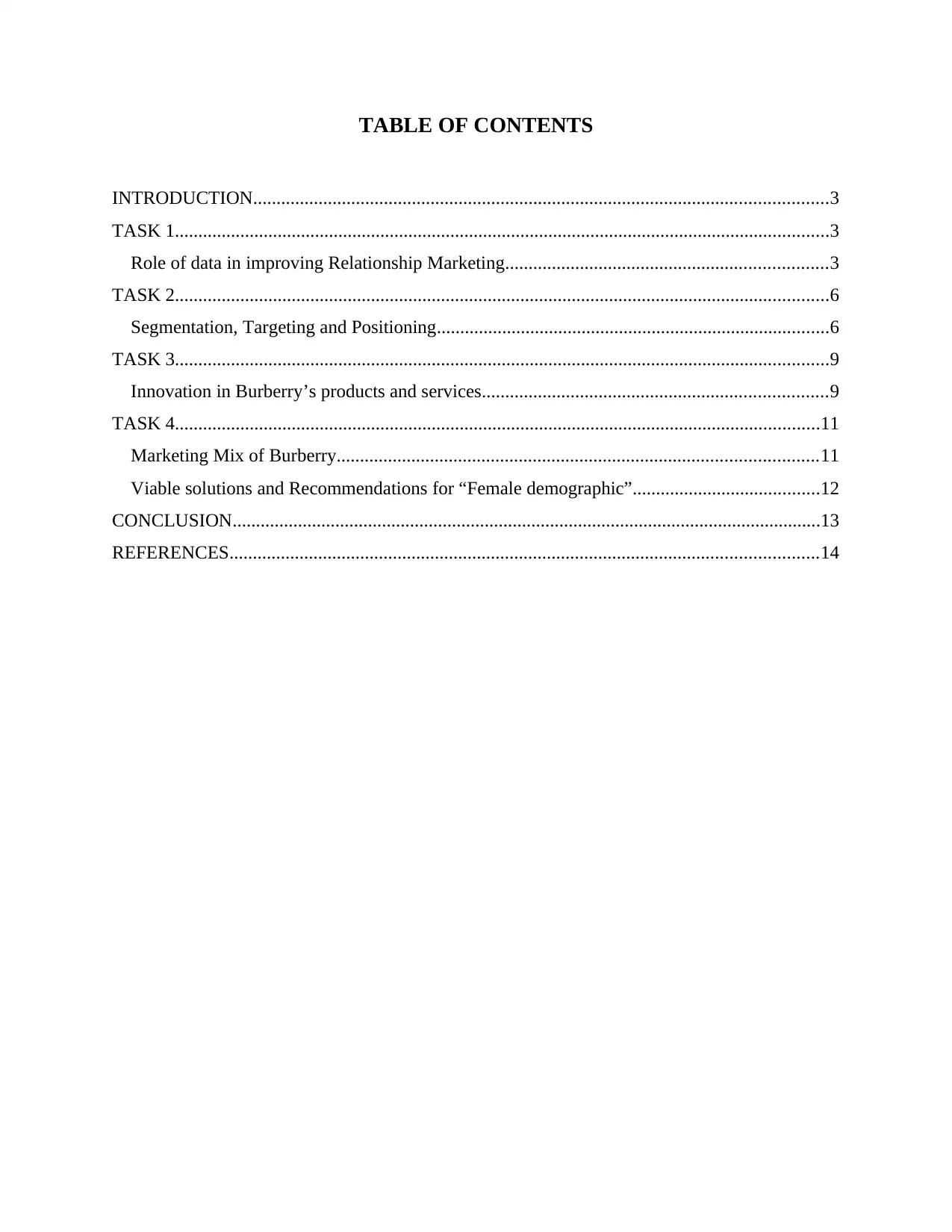
TABLE OF CONTENTS
INTRODUCTION...........................................................................................................................3
TASK 1............................................................................................................................................3
Role of data in improving Relationship Marketing.....................................................................3
TASK 2............................................................................................................................................6
Segmentation, Targeting and Positioning....................................................................................6
TASK 3............................................................................................................................................9
Innovation in Burberry’s products and services..........................................................................9
TASK 4..........................................................................................................................................11
Marketing Mix of Burberry.......................................................................................................11
Viable solutions and Recommendations for “Female demographic”........................................12
CONCLUSION..............................................................................................................................13
REFERENCES..............................................................................................................................14
INTRODUCTION...........................................................................................................................3
TASK 1............................................................................................................................................3
Role of data in improving Relationship Marketing.....................................................................3
TASK 2............................................................................................................................................6
Segmentation, Targeting and Positioning....................................................................................6
TASK 3............................................................................................................................................9
Innovation in Burberry’s products and services..........................................................................9
TASK 4..........................................................................................................................................11
Marketing Mix of Burberry.......................................................................................................11
Viable solutions and Recommendations for “Female demographic”........................................12
CONCLUSION..............................................................................................................................13
REFERENCES..............................................................................................................................14

INTRODUCTION
Marketing management refers to panning, controlling, organising and implementing the
marketing policies, plans, programs, strategies and tactics through efficient market research and
segmentation of targets. It is designed to create and satisfy the needs and demands of the
customers and target markets by offering relevant products and services to generate acceptable
profit and create brand equity. This report is aimed at evaluating how organisations can use sales
and marketing information to strategically plan and take business decisions by focussing on a
UK based organisation Burberry. Burberry is a luxury fashion house and retailer headquartered
in London, England. It designs and distributes ready to wear high end apparels such as trench
coats, leather goods, footwear and cosmetics as well as fashion accessories like sunglasses,
wallets, range of fragrances etc. The report will highlight the role of data in improving
relationship marketing, segmentation, targeting and positioning of a specific segment- apparels
for Burberry, assessing the innovation incorporated in Burberry for satisfying consumer needs,
evaluating marketing mix for the company and providing recommendations and viable solutions
for a specific target group- women to improve the customer needs.
TASK 1
Role of data in improving Relationship Marketing
Relationship marketing is an aspect of CRM or customer relationship management which
is aimed at long-term goals like gaining customer loyalty and improving customer engagement
unlike individual sales and customer acquisition which are short term. Relationship marketing is
devised towards creating strong and emotional customer connections. An ideal relation
marketing consists of different technologies and strategies which create a long-term relationship
with present and prospective customers (Gummesson, 2017). They are Lead generation,
customer data management, Integration of CRM with other marketing systems, customer
experience management, marketing automation tools, multichannel strategies, online and social
CRM, tailored access and targeted information. The data used for marketing operations can be
internal data, competitive intelligence and data from marketing research. Large organisations like
Burberry invest in ‘big data’ to conduct their marketing operations as it is a powerful tool to
analyse large-scale trends to target customers. Data can be used to create stronger and personal
3
Marketing management refers to panning, controlling, organising and implementing the
marketing policies, plans, programs, strategies and tactics through efficient market research and
segmentation of targets. It is designed to create and satisfy the needs and demands of the
customers and target markets by offering relevant products and services to generate acceptable
profit and create brand equity. This report is aimed at evaluating how organisations can use sales
and marketing information to strategically plan and take business decisions by focussing on a
UK based organisation Burberry. Burberry is a luxury fashion house and retailer headquartered
in London, England. It designs and distributes ready to wear high end apparels such as trench
coats, leather goods, footwear and cosmetics as well as fashion accessories like sunglasses,
wallets, range of fragrances etc. The report will highlight the role of data in improving
relationship marketing, segmentation, targeting and positioning of a specific segment- apparels
for Burberry, assessing the innovation incorporated in Burberry for satisfying consumer needs,
evaluating marketing mix for the company and providing recommendations and viable solutions
for a specific target group- women to improve the customer needs.
TASK 1
Role of data in improving Relationship Marketing
Relationship marketing is an aspect of CRM or customer relationship management which
is aimed at long-term goals like gaining customer loyalty and improving customer engagement
unlike individual sales and customer acquisition which are short term. Relationship marketing is
devised towards creating strong and emotional customer connections. An ideal relation
marketing consists of different technologies and strategies which create a long-term relationship
with present and prospective customers (Gummesson, 2017). They are Lead generation,
customer data management, Integration of CRM with other marketing systems, customer
experience management, marketing automation tools, multichannel strategies, online and social
CRM, tailored access and targeted information. The data used for marketing operations can be
internal data, competitive intelligence and data from marketing research. Large organisations like
Burberry invest in ‘big data’ to conduct their marketing operations as it is a powerful tool to
analyse large-scale trends to target customers. Data can be used to create stronger and personal
3
⊘ This is a preview!⊘
Do you want full access?
Subscribe today to unlock all pages.

Trusted by 1+ million students worldwide
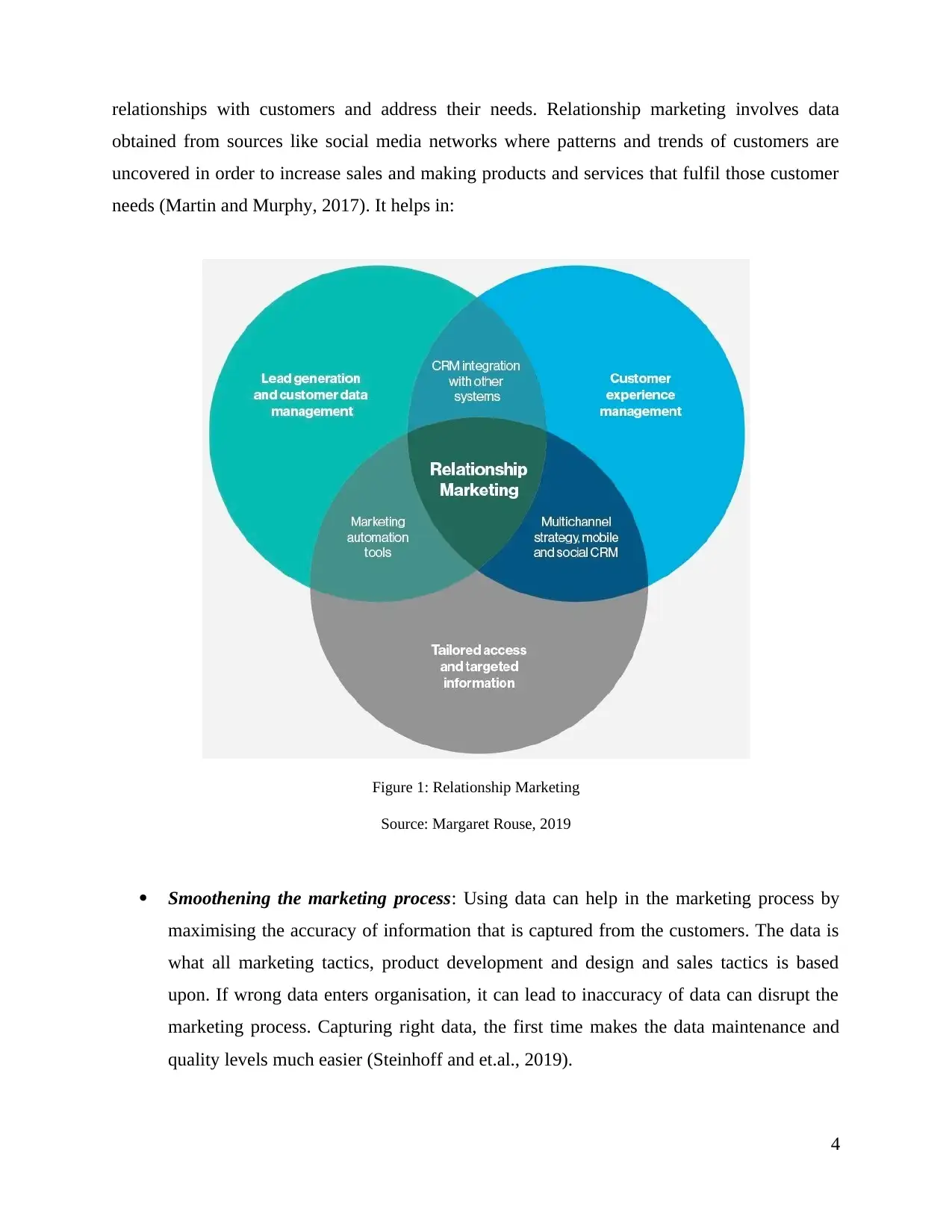
relationships with customers and address their needs. Relationship marketing involves data
obtained from sources like social media networks where patterns and trends of customers are
uncovered in order to increase sales and making products and services that fulfil those customer
needs (Martin and Murphy, 2017). It helps in:
Figure 1: Relationship Marketing
Source: Margaret Rouse, 2019
Smoothening the marketing process: Using data can help in the marketing process by
maximising the accuracy of information that is captured from the customers. The data is
what all marketing tactics, product development and design and sales tactics is based
upon. If wrong data enters organisation, it can lead to inaccuracy of data can disrupt the
marketing process. Capturing right data, the first time makes the data maintenance and
quality levels much easier (Steinhoff and et.al., 2019).
4
obtained from sources like social media networks where patterns and trends of customers are
uncovered in order to increase sales and making products and services that fulfil those customer
needs (Martin and Murphy, 2017). It helps in:
Figure 1: Relationship Marketing
Source: Margaret Rouse, 2019
Smoothening the marketing process: Using data can help in the marketing process by
maximising the accuracy of information that is captured from the customers. The data is
what all marketing tactics, product development and design and sales tactics is based
upon. If wrong data enters organisation, it can lead to inaccuracy of data can disrupt the
marketing process. Capturing right data, the first time makes the data maintenance and
quality levels much easier (Steinhoff and et.al., 2019).
4
Paraphrase This Document
Need a fresh take? Get an instant paraphrase of this document with our AI Paraphraser
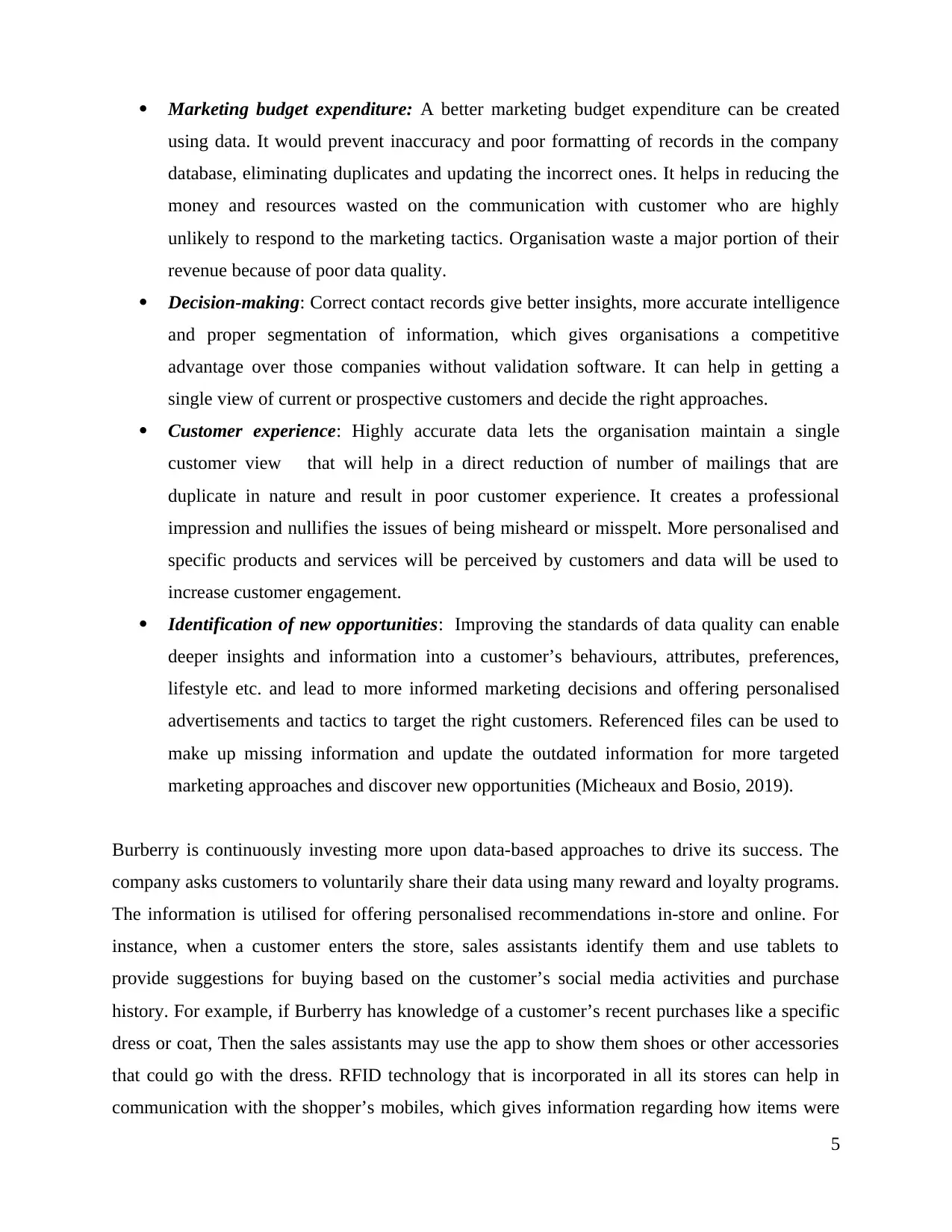
Marketing budget expenditure: A better marketing budget expenditure can be created
using data. It would prevent inaccuracy and poor formatting of records in the company
database, eliminating duplicates and updating the incorrect ones. It helps in reducing the
money and resources wasted on the communication with customer who are highly
unlikely to respond to the marketing tactics. Organisation waste a major portion of their
revenue because of poor data quality.
Decision-making: Correct contact records give better insights, more accurate intelligence
and proper segmentation of information, which gives organisations a competitive
advantage over those companies without validation software. It can help in getting a
single view of current or prospective customers and decide the right approaches.
Customer experience: Highly accurate data lets the organisation maintain a single
customer view that will help in a direct reduction of number of mailings that are
duplicate in nature and result in poor customer experience. It creates a professional
impression and nullifies the issues of being misheard or misspelt. More personalised and
specific products and services will be perceived by customers and data will be used to
increase customer engagement.
Identification of new opportunities: Improving the standards of data quality can enable
deeper insights and information into a customer’s behaviours, attributes, preferences,
lifestyle etc. and lead to more informed marketing decisions and offering personalised
advertisements and tactics to target the right customers. Referenced files can be used to
make up missing information and update the outdated information for more targeted
marketing approaches and discover new opportunities (Micheaux and Bosio, 2019).
Burberry is continuously investing more upon data-based approaches to drive its success. The
company asks customers to voluntarily share their data using many reward and loyalty programs.
The information is utilised for offering personalised recommendations in-store and online. For
instance, when a customer enters the store, sales assistants identify them and use tablets to
provide suggestions for buying based on the customer’s social media activities and purchase
history. For example, if Burberry has knowledge of a customer’s recent purchases like a specific
dress or coat, Then the sales assistants may use the app to show them shoes or other accessories
that could go with the dress. RFID technology that is incorporated in all its stores can help in
communication with the shopper’s mobiles, which gives information regarding how items were
5
using data. It would prevent inaccuracy and poor formatting of records in the company
database, eliminating duplicates and updating the incorrect ones. It helps in reducing the
money and resources wasted on the communication with customer who are highly
unlikely to respond to the marketing tactics. Organisation waste a major portion of their
revenue because of poor data quality.
Decision-making: Correct contact records give better insights, more accurate intelligence
and proper segmentation of information, which gives organisations a competitive
advantage over those companies without validation software. It can help in getting a
single view of current or prospective customers and decide the right approaches.
Customer experience: Highly accurate data lets the organisation maintain a single
customer view that will help in a direct reduction of number of mailings that are
duplicate in nature and result in poor customer experience. It creates a professional
impression and nullifies the issues of being misheard or misspelt. More personalised and
specific products and services will be perceived by customers and data will be used to
increase customer engagement.
Identification of new opportunities: Improving the standards of data quality can enable
deeper insights and information into a customer’s behaviours, attributes, preferences,
lifestyle etc. and lead to more informed marketing decisions and offering personalised
advertisements and tactics to target the right customers. Referenced files can be used to
make up missing information and update the outdated information for more targeted
marketing approaches and discover new opportunities (Micheaux and Bosio, 2019).
Burberry is continuously investing more upon data-based approaches to drive its success. The
company asks customers to voluntarily share their data using many reward and loyalty programs.
The information is utilised for offering personalised recommendations in-store and online. For
instance, when a customer enters the store, sales assistants identify them and use tablets to
provide suggestions for buying based on the customer’s social media activities and purchase
history. For example, if Burberry has knowledge of a customer’s recent purchases like a specific
dress or coat, Then the sales assistants may use the app to show them shoes or other accessories
that could go with the dress. RFID technology that is incorporated in all its stores can help in
communication with the shopper’s mobiles, which gives information regarding how items were
5

manufactured and directions for use. Burberry’s investment in personalised customer
engagement and management programs resulted in an increase of 50% in repeat custom.
Initiatives by the company and its tech transformation emphasizes on building personalised
relationships with individuals and apply these in the intimate world of luxury marketing.
TASK 2
Segmentation, Targeting and Positioning
Burberry recognises the importance of market segmentation to devise relevant marketing
strategies for its wide range of products ready to wear apparels, trench coats, fashion accessories,
leather wear, eyewear, footwear, fragrances and cosmetics. The sales and distribution of
Burberry is conducted across the globe and therefore differentiation of target markets, actual
products and appropriate positioning for selling products is essential. The market segmentation
of apparels segment of Burberry is as follows:
Market segmentation is used to divide market into segments with distinct characteristics,
behaviour and needs (Camilleri, 2018). The apparel product-line can be segmented into various
categories for assessing the marketing needs.
Geographic segmentation: On the basis of location, the apparel segments can be divided
into categories for specific continent and culture. The use of infamous trench coats is
only present in cold countries like UK, Italy, North America, South Korea and Japan. For
hot countries, products with light fabric and focus on other clothing style which appeals
to the need of the people have to be introduced.
Demographic segmentation: On the basis of income level, Burberry has to target only
high-end customers as they sell luxury products. The age and gender have to considered
while marketing their products, an age range of 15- 35 is most appropriate for marketing
of fashionable clothes. On the basis of religion, items like fashionable hijabs can be
introduced in the middle eastern countries. Cosmetic line has to be targeted towards high
end female customers. Currently, Burberry has a black label and blue label for its clothes
in Japan as per the looseness and tightness of apparels (Sheldon, 2016).
6
engagement and management programs resulted in an increase of 50% in repeat custom.
Initiatives by the company and its tech transformation emphasizes on building personalised
relationships with individuals and apply these in the intimate world of luxury marketing.
TASK 2
Segmentation, Targeting and Positioning
Burberry recognises the importance of market segmentation to devise relevant marketing
strategies for its wide range of products ready to wear apparels, trench coats, fashion accessories,
leather wear, eyewear, footwear, fragrances and cosmetics. The sales and distribution of
Burberry is conducted across the globe and therefore differentiation of target markets, actual
products and appropriate positioning for selling products is essential. The market segmentation
of apparels segment of Burberry is as follows:
Market segmentation is used to divide market into segments with distinct characteristics,
behaviour and needs (Camilleri, 2018). The apparel product-line can be segmented into various
categories for assessing the marketing needs.
Geographic segmentation: On the basis of location, the apparel segments can be divided
into categories for specific continent and culture. The use of infamous trench coats is
only present in cold countries like UK, Italy, North America, South Korea and Japan. For
hot countries, products with light fabric and focus on other clothing style which appeals
to the need of the people have to be introduced.
Demographic segmentation: On the basis of income level, Burberry has to target only
high-end customers as they sell luxury products. The age and gender have to considered
while marketing their products, an age range of 15- 35 is most appropriate for marketing
of fashionable clothes. On the basis of religion, items like fashionable hijabs can be
introduced in the middle eastern countries. Cosmetic line has to be targeted towards high
end female customers. Currently, Burberry has a black label and blue label for its clothes
in Japan as per the looseness and tightness of apparels (Sheldon, 2016).
6
⊘ This is a preview!⊘
Do you want full access?
Subscribe today to unlock all pages.

Trusted by 1+ million students worldwide

Psychographic segmentation: This segmentation is based on the values, beliefs,
perceptions, lifestyle, social class or personality traits of the potential customers.
Burberry has to target the customers who are concerned with the status and glamour of
luxury clothing as it is a specifically luxury brand company.
Behavioural segmentation: The purchasing habits, decision-making patterns spending
habits, brand interactions and user status of customers have to assessed and database
marketing can be devised accordingly. A more targeted approach can be developed by
Burberry on the basis of consumer behaviours like spending a lot of time in trials, search
for only unique designs or specific colours etc. This segmentation can also be done either
using occasion segmentation: classifying the market on the basis of occasions when
customers get the ideas to purchase, actually purchase and use the items. Benefit
segmentation is done by dividing the market on the basis of the value and benefits
customers seek from the clothes. Segmentation can be done on the basis of user rate and
loyalty status which are available to the company from its database and membership
cards.
Market targeting is done to evaluate each market’s attractiveness and selection of specific
segments to enter. Factors like segment size, growth potential, structural attractiveness,
organisational objectives and resources have to be considered. It consists of a consumer’s
common needs and attributes that company decides to serve (Nadube and Didia, 2018).
Undifferentiated or mass marketing: In this strategy, company decides to give importance
on whole market rather than differences in the market segment. Burberry does this for all
the apparels which are targeted according to innovation or luxury fashion.
Differentiated marketing: A market coverage strategy is used which targets several
different market segments and designs and creates separate offers focussing on each. All
market segments like geographical, demographic, behavioural are targeted.
Niche marketing: A concentrated targeting approach, where the company selects a large
share of single or a few niches. Burberry targets only UK based customers for the sale of
trench coats as they are most popular over there and satisfy the needs of a particular
segment.
7
perceptions, lifestyle, social class or personality traits of the potential customers.
Burberry has to target the customers who are concerned with the status and glamour of
luxury clothing as it is a specifically luxury brand company.
Behavioural segmentation: The purchasing habits, decision-making patterns spending
habits, brand interactions and user status of customers have to assessed and database
marketing can be devised accordingly. A more targeted approach can be developed by
Burberry on the basis of consumer behaviours like spending a lot of time in trials, search
for only unique designs or specific colours etc. This segmentation can also be done either
using occasion segmentation: classifying the market on the basis of occasions when
customers get the ideas to purchase, actually purchase and use the items. Benefit
segmentation is done by dividing the market on the basis of the value and benefits
customers seek from the clothes. Segmentation can be done on the basis of user rate and
loyalty status which are available to the company from its database and membership
cards.
Market targeting is done to evaluate each market’s attractiveness and selection of specific
segments to enter. Factors like segment size, growth potential, structural attractiveness,
organisational objectives and resources have to be considered. It consists of a consumer’s
common needs and attributes that company decides to serve (Nadube and Didia, 2018).
Undifferentiated or mass marketing: In this strategy, company decides to give importance
on whole market rather than differences in the market segment. Burberry does this for all
the apparels which are targeted according to innovation or luxury fashion.
Differentiated marketing: A market coverage strategy is used which targets several
different market segments and designs and creates separate offers focussing on each. All
market segments like geographical, demographic, behavioural are targeted.
Niche marketing: A concentrated targeting approach, where the company selects a large
share of single or a few niches. Burberry targets only UK based customers for the sale of
trench coats as they are most popular over there and satisfy the needs of a particular
segment.
7
Paraphrase This Document
Need a fresh take? Get an instant paraphrase of this document with our AI Paraphraser
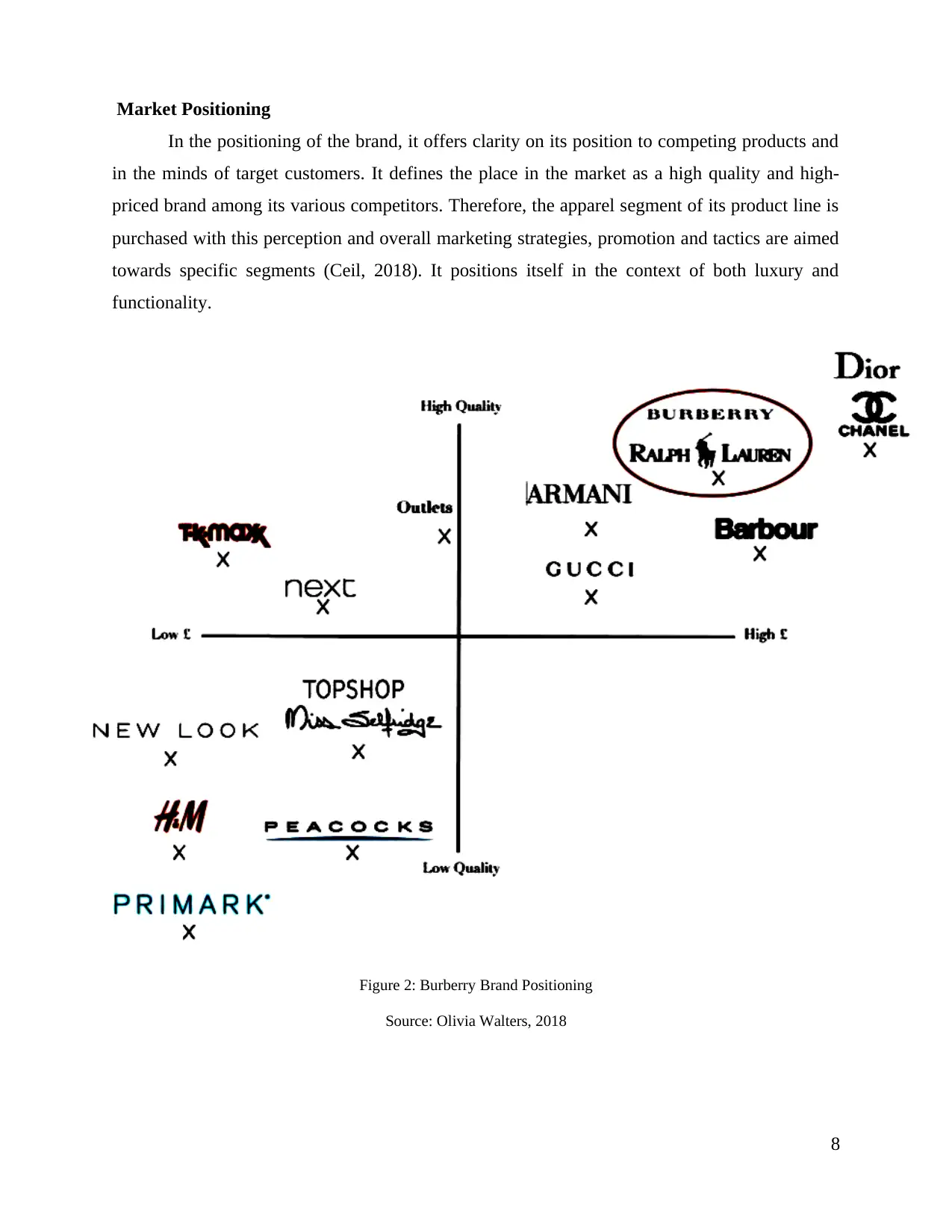
Market Positioning
In the positioning of the brand, it offers clarity on its position to competing products and
in the minds of target customers. It defines the place in the market as a high quality and high-
priced brand among its various competitors. Therefore, the apparel segment of its product line is
purchased with this perception and overall marketing strategies, promotion and tactics are aimed
towards specific segments (Ceil, 2018). It positions itself in the context of both luxury and
functionality.
Figure 2: Burberry Brand Positioning
Source: Olivia Walters, 2018
8
In the positioning of the brand, it offers clarity on its position to competing products and
in the minds of target customers. It defines the place in the market as a high quality and high-
priced brand among its various competitors. Therefore, the apparel segment of its product line is
purchased with this perception and overall marketing strategies, promotion and tactics are aimed
towards specific segments (Ceil, 2018). It positions itself in the context of both luxury and
functionality.
Figure 2: Burberry Brand Positioning
Source: Olivia Walters, 2018
8
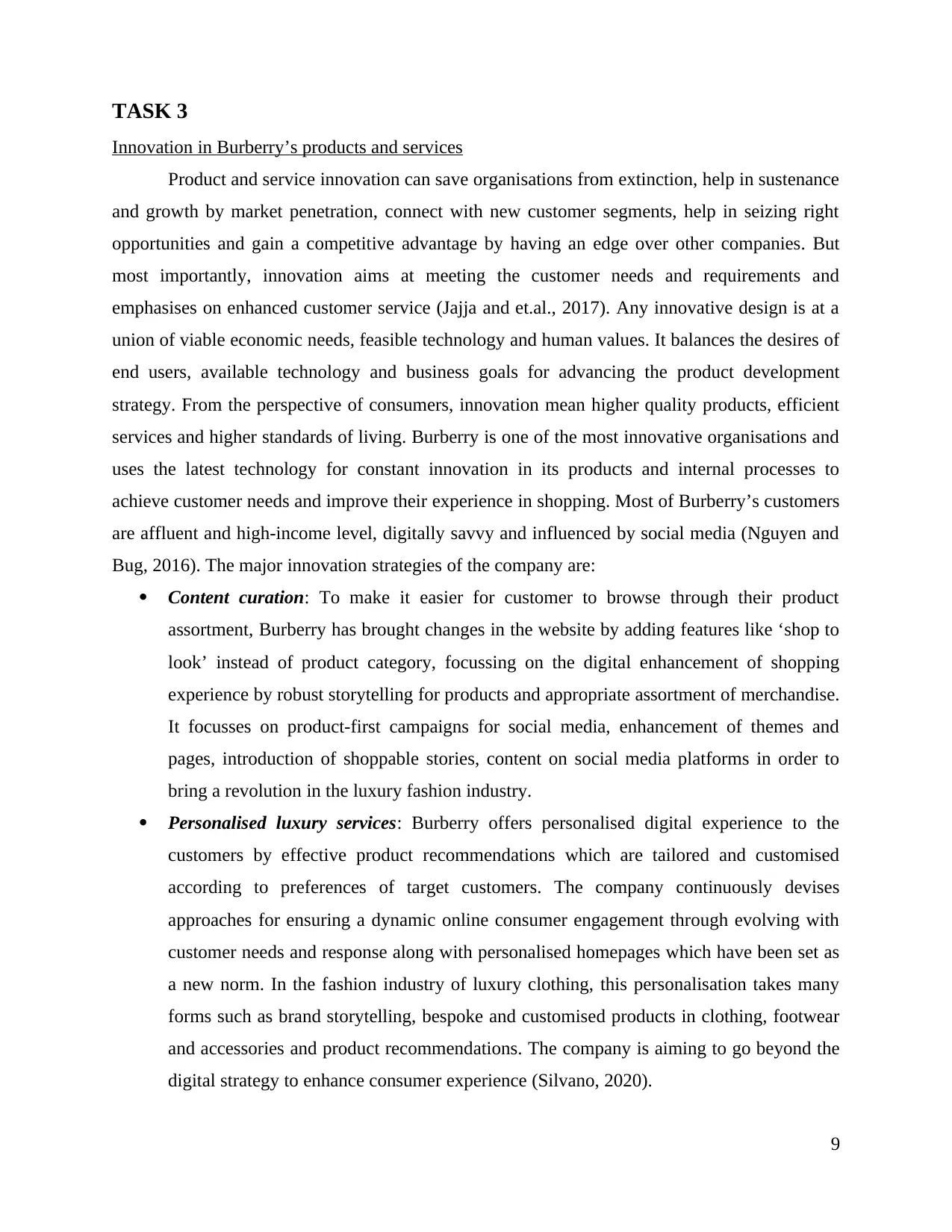
TASK 3
Innovation in Burberry’s products and services
Product and service innovation can save organisations from extinction, help in sustenance
and growth by market penetration, connect with new customer segments, help in seizing right
opportunities and gain a competitive advantage by having an edge over other companies. But
most importantly, innovation aims at meeting the customer needs and requirements and
emphasises on enhanced customer service (Jajja and et.al., 2017). Any innovative design is at a
union of viable economic needs, feasible technology and human values. It balances the desires of
end users, available technology and business goals for advancing the product development
strategy. From the perspective of consumers, innovation mean higher quality products, efficient
services and higher standards of living. Burberry is one of the most innovative organisations and
uses the latest technology for constant innovation in its products and internal processes to
achieve customer needs and improve their experience in shopping. Most of Burberry’s customers
are affluent and high-income level, digitally savvy and influenced by social media (Nguyen and
Bug, 2016). The major innovation strategies of the company are:
Content curation: To make it easier for customer to browse through their product
assortment, Burberry has brought changes in the website by adding features like ‘shop to
look’ instead of product category, focussing on the digital enhancement of shopping
experience by robust storytelling for products and appropriate assortment of merchandise.
It focusses on product-first campaigns for social media, enhancement of themes and
pages, introduction of shoppable stories, content on social media platforms in order to
bring a revolution in the luxury fashion industry.
Personalised luxury services: Burberry offers personalised digital experience to the
customers by effective product recommendations which are tailored and customised
according to preferences of target customers. The company continuously devises
approaches for ensuring a dynamic online consumer engagement through evolving with
customer needs and response along with personalised homepages which have been set as
a new norm. In the fashion industry of luxury clothing, this personalisation takes many
forms such as brand storytelling, bespoke and customised products in clothing, footwear
and accessories and product recommendations. The company is aiming to go beyond the
digital strategy to enhance consumer experience (Silvano, 2020).
9
Innovation in Burberry’s products and services
Product and service innovation can save organisations from extinction, help in sustenance
and growth by market penetration, connect with new customer segments, help in seizing right
opportunities and gain a competitive advantage by having an edge over other companies. But
most importantly, innovation aims at meeting the customer needs and requirements and
emphasises on enhanced customer service (Jajja and et.al., 2017). Any innovative design is at a
union of viable economic needs, feasible technology and human values. It balances the desires of
end users, available technology and business goals for advancing the product development
strategy. From the perspective of consumers, innovation mean higher quality products, efficient
services and higher standards of living. Burberry is one of the most innovative organisations and
uses the latest technology for constant innovation in its products and internal processes to
achieve customer needs and improve their experience in shopping. Most of Burberry’s customers
are affluent and high-income level, digitally savvy and influenced by social media (Nguyen and
Bug, 2016). The major innovation strategies of the company are:
Content curation: To make it easier for customer to browse through their product
assortment, Burberry has brought changes in the website by adding features like ‘shop to
look’ instead of product category, focussing on the digital enhancement of shopping
experience by robust storytelling for products and appropriate assortment of merchandise.
It focusses on product-first campaigns for social media, enhancement of themes and
pages, introduction of shoppable stories, content on social media platforms in order to
bring a revolution in the luxury fashion industry.
Personalised luxury services: Burberry offers personalised digital experience to the
customers by effective product recommendations which are tailored and customised
according to preferences of target customers. The company continuously devises
approaches for ensuring a dynamic online consumer engagement through evolving with
customer needs and response along with personalised homepages which have been set as
a new norm. In the fashion industry of luxury clothing, this personalisation takes many
forms such as brand storytelling, bespoke and customised products in clothing, footwear
and accessories and product recommendations. The company is aiming to go beyond the
digital strategy to enhance consumer experience (Silvano, 2020).
9
⊘ This is a preview!⊘
Do you want full access?
Subscribe today to unlock all pages.

Trusted by 1+ million students worldwide
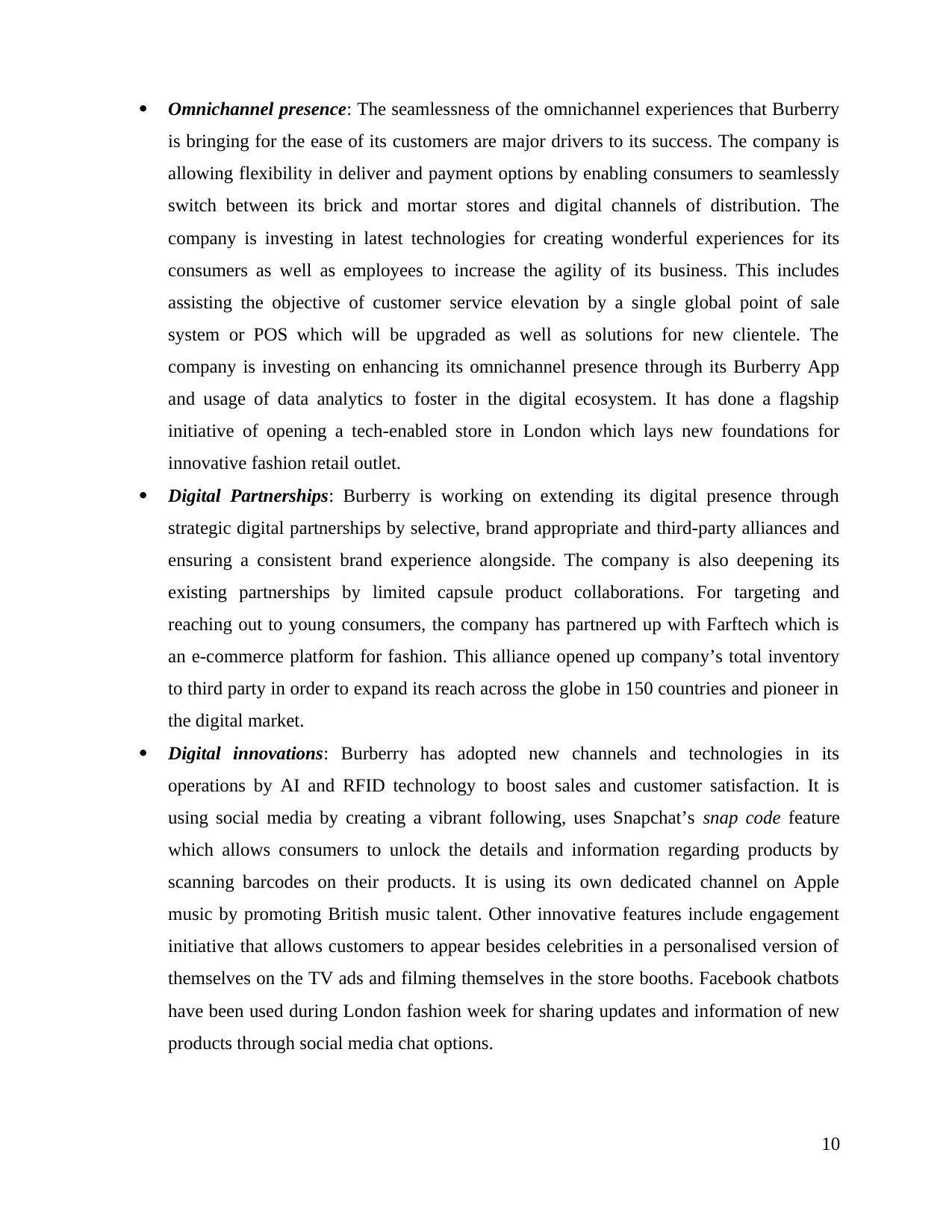
Omnichannel presence: The seamlessness of the omnichannel experiences that Burberry
is bringing for the ease of its customers are major drivers to its success. The company is
allowing flexibility in deliver and payment options by enabling consumers to seamlessly
switch between its brick and mortar stores and digital channels of distribution. The
company is investing in latest technologies for creating wonderful experiences for its
consumers as well as employees to increase the agility of its business. This includes
assisting the objective of customer service elevation by a single global point of sale
system or POS which will be upgraded as well as solutions for new clientele. The
company is investing on enhancing its omnichannel presence through its Burberry App
and usage of data analytics to foster in the digital ecosystem. It has done a flagship
initiative of opening a tech-enabled store in London which lays new foundations for
innovative fashion retail outlet.
Digital Partnerships: Burberry is working on extending its digital presence through
strategic digital partnerships by selective, brand appropriate and third-party alliances and
ensuring a consistent brand experience alongside. The company is also deepening its
existing partnerships by limited capsule product collaborations. For targeting and
reaching out to young consumers, the company has partnered up with Farftech which is
an e-commerce platform for fashion. This alliance opened up company’s total inventory
to third party in order to expand its reach across the globe in 150 countries and pioneer in
the digital market.
Digital innovations: Burberry has adopted new channels and technologies in its
operations by AI and RFID technology to boost sales and customer satisfaction. It is
using social media by creating a vibrant following, uses Snapchat’s snap code feature
which allows consumers to unlock the details and information regarding products by
scanning barcodes on their products. It is using its own dedicated channel on Apple
music by promoting British music talent. Other innovative features include engagement
initiative that allows customers to appear besides celebrities in a personalised version of
themselves on the TV ads and filming themselves in the store booths. Facebook chatbots
have been used during London fashion week for sharing updates and information of new
products through social media chat options.
10
is bringing for the ease of its customers are major drivers to its success. The company is
allowing flexibility in deliver and payment options by enabling consumers to seamlessly
switch between its brick and mortar stores and digital channels of distribution. The
company is investing in latest technologies for creating wonderful experiences for its
consumers as well as employees to increase the agility of its business. This includes
assisting the objective of customer service elevation by a single global point of sale
system or POS which will be upgraded as well as solutions for new clientele. The
company is investing on enhancing its omnichannel presence through its Burberry App
and usage of data analytics to foster in the digital ecosystem. It has done a flagship
initiative of opening a tech-enabled store in London which lays new foundations for
innovative fashion retail outlet.
Digital Partnerships: Burberry is working on extending its digital presence through
strategic digital partnerships by selective, brand appropriate and third-party alliances and
ensuring a consistent brand experience alongside. The company is also deepening its
existing partnerships by limited capsule product collaborations. For targeting and
reaching out to young consumers, the company has partnered up with Farftech which is
an e-commerce platform for fashion. This alliance opened up company’s total inventory
to third party in order to expand its reach across the globe in 150 countries and pioneer in
the digital market.
Digital innovations: Burberry has adopted new channels and technologies in its
operations by AI and RFID technology to boost sales and customer satisfaction. It is
using social media by creating a vibrant following, uses Snapchat’s snap code feature
which allows consumers to unlock the details and information regarding products by
scanning barcodes on their products. It is using its own dedicated channel on Apple
music by promoting British music talent. Other innovative features include engagement
initiative that allows customers to appear besides celebrities in a personalised version of
themselves on the TV ads and filming themselves in the store booths. Facebook chatbots
have been used during London fashion week for sharing updates and information of new
products through social media chat options.
10
Paraphrase This Document
Need a fresh take? Get an instant paraphrase of this document with our AI Paraphraser
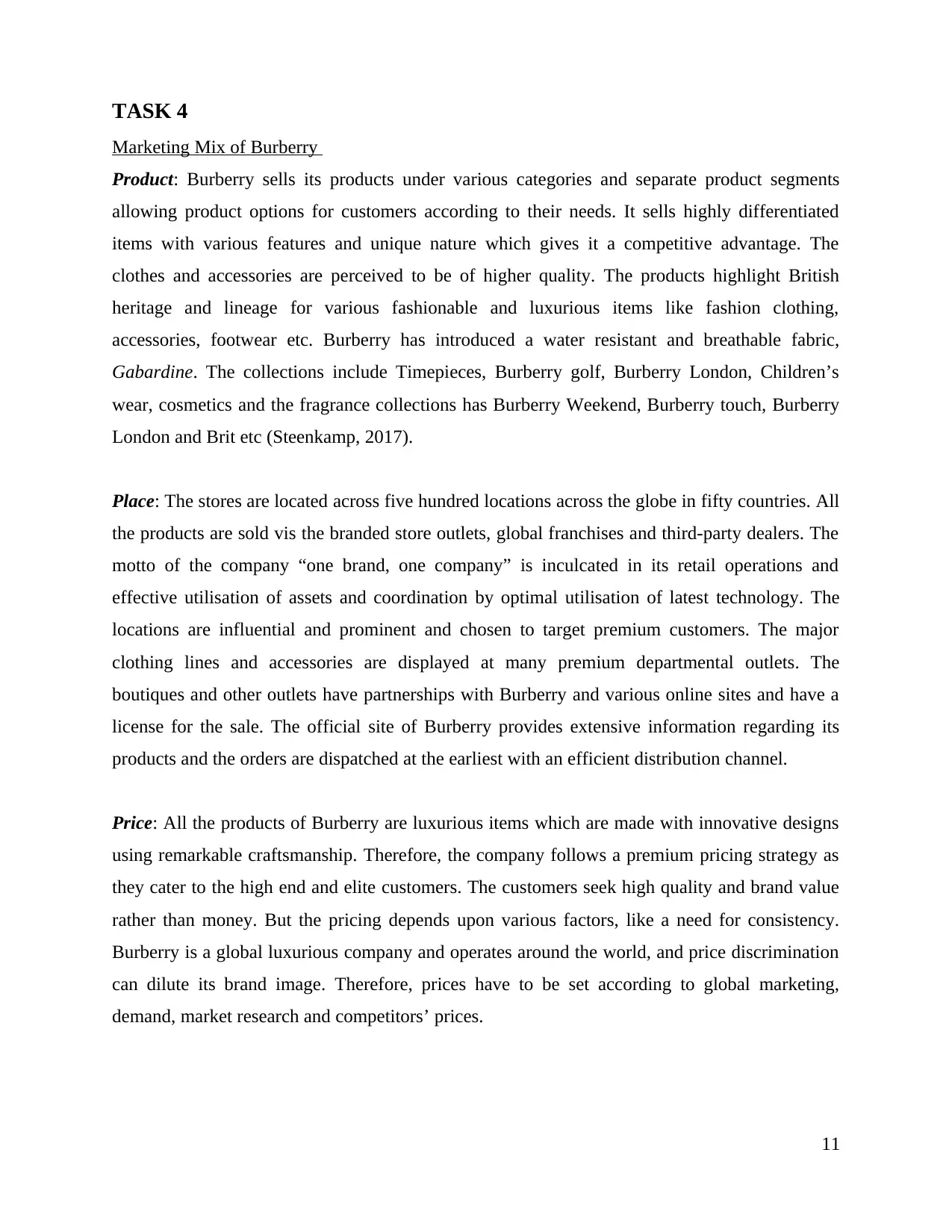
TASK 4
Marketing Mix of Burberry
Product: Burberry sells its products under various categories and separate product segments
allowing product options for customers according to their needs. It sells highly differentiated
items with various features and unique nature which gives it a competitive advantage. The
clothes and accessories are perceived to be of higher quality. The products highlight British
heritage and lineage for various fashionable and luxurious items like fashion clothing,
accessories, footwear etc. Burberry has introduced a water resistant and breathable fabric,
Gabardine. The collections include Timepieces, Burberry golf, Burberry London, Children’s
wear, cosmetics and the fragrance collections has Burberry Weekend, Burberry touch, Burberry
London and Brit etc (Steenkamp, 2017).
Place: The stores are located across five hundred locations across the globe in fifty countries. All
the products are sold vis the branded store outlets, global franchises and third-party dealers. The
motto of the company “one brand, one company” is inculcated in its retail operations and
effective utilisation of assets and coordination by optimal utilisation of latest technology. The
locations are influential and prominent and chosen to target premium customers. The major
clothing lines and accessories are displayed at many premium departmental outlets. The
boutiques and other outlets have partnerships with Burberry and various online sites and have a
license for the sale. The official site of Burberry provides extensive information regarding its
products and the orders are dispatched at the earliest with an efficient distribution channel.
Price: All the products of Burberry are luxurious items which are made with innovative designs
using remarkable craftsmanship. Therefore, the company follows a premium pricing strategy as
they cater to the high end and elite customers. The customers seek high quality and brand value
rather than money. But the pricing depends upon various factors, like a need for consistency.
Burberry is a global luxurious company and operates around the world, and price discrimination
can dilute its brand image. Therefore, prices have to be set according to global marketing,
demand, market research and competitors’ prices.
11
Marketing Mix of Burberry
Product: Burberry sells its products under various categories and separate product segments
allowing product options for customers according to their needs. It sells highly differentiated
items with various features and unique nature which gives it a competitive advantage. The
clothes and accessories are perceived to be of higher quality. The products highlight British
heritage and lineage for various fashionable and luxurious items like fashion clothing,
accessories, footwear etc. Burberry has introduced a water resistant and breathable fabric,
Gabardine. The collections include Timepieces, Burberry golf, Burberry London, Children’s
wear, cosmetics and the fragrance collections has Burberry Weekend, Burberry touch, Burberry
London and Brit etc (Steenkamp, 2017).
Place: The stores are located across five hundred locations across the globe in fifty countries. All
the products are sold vis the branded store outlets, global franchises and third-party dealers. The
motto of the company “one brand, one company” is inculcated in its retail operations and
effective utilisation of assets and coordination by optimal utilisation of latest technology. The
locations are influential and prominent and chosen to target premium customers. The major
clothing lines and accessories are displayed at many premium departmental outlets. The
boutiques and other outlets have partnerships with Burberry and various online sites and have a
license for the sale. The official site of Burberry provides extensive information regarding its
products and the orders are dispatched at the earliest with an efficient distribution channel.
Price: All the products of Burberry are luxurious items which are made with innovative designs
using remarkable craftsmanship. Therefore, the company follows a premium pricing strategy as
they cater to the high end and elite customers. The customers seek high quality and brand value
rather than money. But the pricing depends upon various factors, like a need for consistency.
Burberry is a global luxurious company and operates around the world, and price discrimination
can dilute its brand image. Therefore, prices have to be set according to global marketing,
demand, market research and competitors’ prices.
11

Promotion: The promotions and advertisements of Burberry are given major importance and
high investments are made for marketing tactics and digital marketing. High class lifestyle
magazines are selected for placing advertisements and a major emphasis is given on visual media
to launch and highlight the products. Burberry uses all kinds of promotional activities such as
print ads, online marketing and social media. Burberry aims at creating an insistent and
consistent brand awareness. The brand prominently relies on celebrity endorsements with
ambassadors like Emma Watson, Romeo Beckham and other British models Edie Campbell,
Max Rendell, Charlotte Wiggins etc (Blut, Teller and Floh, 2018).
Viable solutions and Recommendations for “Female demographic”
In Burberry, majority of the revenue comes through the women customers while nearly
20% of the sales account for Menswear. In order to meet the customer needs and requirements of
the women customers for the clothing segment, Burberry can come up with major marketing
tactics and strategies such as:
Functionality: The products such as clothing designs, fashion accessories, cosmetic,
footwear should aim at serving the needs of the women to solve problems and cater to
their desire. The core benefits like quality, glamour and uniqueness have to be addressed
by the company.
Convenience: Using digital and omnichannel presence to ease to the process of purchase
by providing user friendly interface on its websites and customer engagement in its
outlets along with easy payment options (Vavrová, 2019).
Experience: The customer experience of women shopping in the bricks and mortar stores
has to be enhanced by incorporating data-based customer relationship by catering to
indicial needs. The company can provide personalised and customizable clothing options
and sales assistants have to be trained to recognise the needs and give appropriate product
recommendations. The experience should be seamless and customers shouldn’t be left
confused at any point in the purchase process.
Reliability: The reliability of the product line means that the manner in which products
are advertised have to be made available as actual and augmented products which cater to
the needs of the women. This includes availability of specific sizes, fabrics, unique
designs etc, that is elaborated in promotional activities.
12
high investments are made for marketing tactics and digital marketing. High class lifestyle
magazines are selected for placing advertisements and a major emphasis is given on visual media
to launch and highlight the products. Burberry uses all kinds of promotional activities such as
print ads, online marketing and social media. Burberry aims at creating an insistent and
consistent brand awareness. The brand prominently relies on celebrity endorsements with
ambassadors like Emma Watson, Romeo Beckham and other British models Edie Campbell,
Max Rendell, Charlotte Wiggins etc (Blut, Teller and Floh, 2018).
Viable solutions and Recommendations for “Female demographic”
In Burberry, majority of the revenue comes through the women customers while nearly
20% of the sales account for Menswear. In order to meet the customer needs and requirements of
the women customers for the clothing segment, Burberry can come up with major marketing
tactics and strategies such as:
Functionality: The products such as clothing designs, fashion accessories, cosmetic,
footwear should aim at serving the needs of the women to solve problems and cater to
their desire. The core benefits like quality, glamour and uniqueness have to be addressed
by the company.
Convenience: Using digital and omnichannel presence to ease to the process of purchase
by providing user friendly interface on its websites and customer engagement in its
outlets along with easy payment options (Vavrová, 2019).
Experience: The customer experience of women shopping in the bricks and mortar stores
has to be enhanced by incorporating data-based customer relationship by catering to
indicial needs. The company can provide personalised and customizable clothing options
and sales assistants have to be trained to recognise the needs and give appropriate product
recommendations. The experience should be seamless and customers shouldn’t be left
confused at any point in the purchase process.
Reliability: The reliability of the product line means that the manner in which products
are advertised have to be made available as actual and augmented products which cater to
the needs of the women. This includes availability of specific sizes, fabrics, unique
designs etc, that is elaborated in promotional activities.
12
⊘ This is a preview!⊘
Do you want full access?
Subscribe today to unlock all pages.

Trusted by 1+ million students worldwide
1 out of 14
Related Documents
Your All-in-One AI-Powered Toolkit for Academic Success.
+13062052269
info@desklib.com
Available 24*7 on WhatsApp / Email
![[object Object]](/_next/static/media/star-bottom.7253800d.svg)
Unlock your academic potential
Copyright © 2020–2025 A2Z Services. All Rights Reserved. Developed and managed by ZUCOL.





